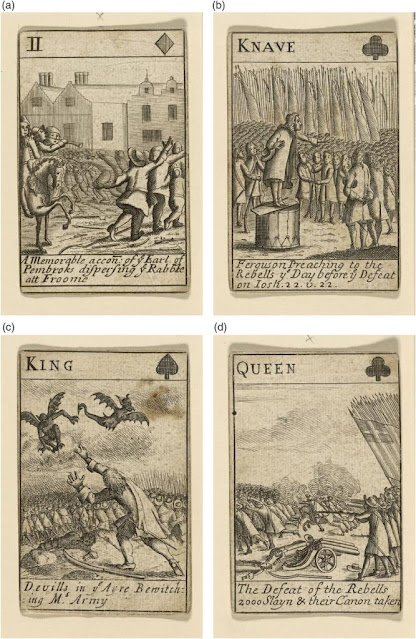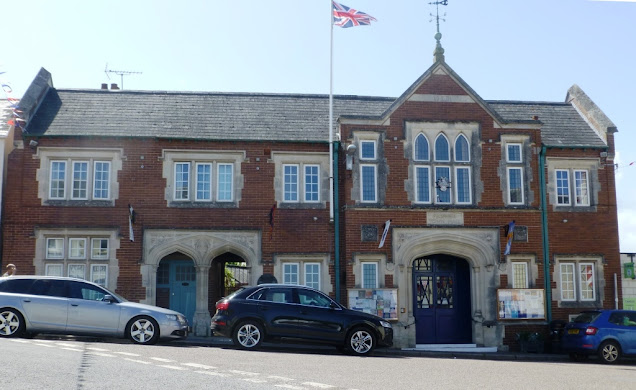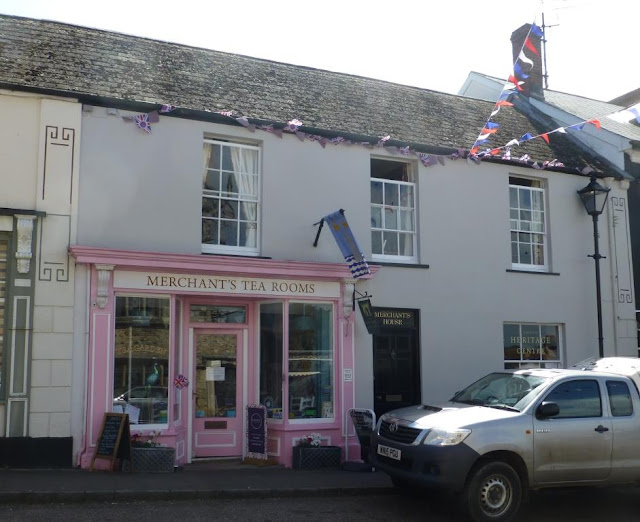A Monmouth rebel greets you at the car park in Colyton
Most Devonians know that East Budleigh was the birthplace of
Sir Walter Raleigh, and by now, I hope, quite a few more know that it was also
where Roger Conant was born.
Less than 20 miles north-east of the village is the attractive little town of Colyton. Like East Budleigh it’s noted for its picturesque old buildings but is more celebrated as ‘the most rebellious town in Devon’ because of the role that many of its inhabitants played in the Monmouth Rebellion of 1685 during the reign of the Catholic King James II.
The town was one of the main areas of religious dissent in East Devon. When the Protestant Duke of Monmouth, an illegitimate son of King Charles II, landed on the coast of Dorset in June that year, 105 men from Colyton - more than any other Devon town - chose to follow him rather than remain loyal to the Crown.
The Battle of Sedgemoor is often referred to as the last pitched
battle fought on English soil. The four playing cards from this
commemorative pack of 1685 illustrate incidents in Monmouth’s rebellion and
were evidently produced as government propaganda: the ‘King’ card depicts devils in
the air bewitching Monmouth’s army. Image © The Trustees of the
British Museum
Monmouth was defeated at the Battle of Sedgemoor on 6 July. It’s not known how many Colyton men were killed in the battle, but thirty-three were taken prisoner. Twenty-four were sentenced to be transported into slavery, and fifteen were hanged.
Just over a century earlier, Colyton people showed a similar independence of spirit during the reign of Henry VIII. But the circumstances were less bloody and the events are very much part of Roger Conant’s story.
Henry
Courtenay, KG, shown 2nd from left wearing a mantle displaying his arms, detail
from procession of Garter Knights in the Black Book of the Garter, c.1535.
Image credit: Royal Collection, Windsor; Wikipedia
Much of the land in Devon and Cornwall was owned by Henry Courtenay, 1st Marquess of Exeter and Earl of Devon, who was a cousin and friend of Henry VIII. But the religious and political upheavals of the English Reformation in the 1530s led Courtenay into rivalry with Thomas Cromwell.
Portrait of Thomas Cromwell in
1532-3 by Hans Holbein the Younger. Image credit: The Frick Collection;
Wikipedia
As Henry’s chief minister,
Cromwell had sufficient influence at Court to destroy his enemies, and in
November 1538, Courtenay was arrested on suspicion of treason. After a brief
trial he was beheaded on 9 December at Tower Hill in London. His lands were
seized by the Crown and the Earldom of Devon was declared forfeit.
Old Church House near St Andrew’s Church dates from 1612, and is a three-storey building formerly used by the Colyton Feoffees. Feoffee is an ancient word meaning a trustee who holds a 'fief', i.e. an estate in land for the use of the beneficial owner.
A group of 20 Colyton merchants saw an opportunity to
create, with royal agreement, a form of self-government in the town, and travelled
to Westminster to state their case in 1546.
The King agreed to the sale of Courtney’s estates in the town – ‘the manor of Coliton’ – subject to the proceeds being used for ‘good, godly and commendable uses’. On 6 January 1546, the Colyton Chamber of Feoffees was established.
The door of Old Church House
Not just any old town council building. The inscription above the front door proudly states that it is the Feoffees Town Hall
The front of Colyton Grammar School in 2013. The School moved in 1927 from Colyton to its present site in the nearby village of Colyford Image credit: Bookwork72; Wikipedia
The English Reformation had a major impact in the area of education. What has become known as the Dissolution of the Monasteries was followed by a surge in the number of grammar schools. By 1540 all the abbeys, friaries and other religious houses with their cloister schools had been abolished.
Nine miles west of Colyton, at Ottery St Mary, the choir school established by Bishop Grandisson in 1335 was replaced by a grammar school and named The King’s School in 1545.
One of the first acts of the Feoffees was the founding of Colyton Grammar School ‘for the goodly and virtuous education of children in Colyton forever’.
This Grade II listed building, next to St Andrew's Church in Colyton, was built in 1835. For a time it was used by Colyton Grammar School before the move in 1927. Thanks to Jane Dauncey for this information. Jane organises walking tours of Colyton. See www.colytonhistory.co.uk/colyton-history-tours.php
The astute Colyton merchants during their visit to London may even have suggested that the new school be named in the monarch’s honour like Ottery St Mary’s grammar school. They would have guessed that following suit would be an obvious way of flattering King Henry to achieve their aim of self-government.
Prominent among these merchants who travelled to London in 1546 was John Clarke, whose daughter Agnes would marry Roger Conant’s father, Richard. Clarke’s importance in the town is evident from the entry in parish records following his death:
"John Clarke, the elder of Coliton, merchant was buried IX of Aprill, who in his lyfe time was the cheffest traviler of the purchas of the manor of Coliton, and the markets, with other lyberties pertaining the same, as aperieth by the pattent - and deceased the VI day of Aprill 1585."
A walking tour of Colyton might include all the buildings
that would have stood in John Clarke’s time. No doubt Roger Conant would have
been familiar with them during visits to his grandparents.
Brerewood House
On the west side of St Andrew’s Church stands Brerewood House,
currently the vicarage. It was the home of Dr Thomas Brerewood, who was Vicar
of Colyton from 1524 to 1544 and Chancellor to John Veysey, Bishop of Exeter from
1519 to 1551.
The front entrance to Brerewood House
The Merchant’s House
Other houses in Colyton like this building, known as the
Merchant’s House, are evidence of the town’s wealth in the past. The elegant plasterwork
of the ceilings in the front part of the house dates from the early 17th
century. The building now includes the Colyton Heritage Centre.
The Great House
Away from the town centre on South Street is the Great House.
It was home to the Yonge or Young family who settled in Devon during the reign
of King Henry VII and were prominent wool merchants. The building is largely
early 17th century, but two Tudor fireplaces indicate that it was
originally an Elizabethan mansion.
The tannery of J. & F.J. Baker & Co Ltd. King
Street, Colyton
My tour of Colyton ended at this unprepossessing building
next to a nice garden centre. It’s something of a contrast to the town’s
ancient buildings but appearances can be deceptive. J. & F.J. Baker is Britain's
only remaining traditional oak bark tannery.
Oak bark leather has been tanned here
on the banks of the River Coly since Roman times, with a process that has
hardly changed for centuries.The long slow tannage ensures that the natural
fibres that make up a hide are allowed to remain in their natural weave. This
produces a nice firm, hard wearing piece of leather, with good water
resistance. Baker's leather is used for bespoke shoe-making and is also ideal
for saddlery and harness leathers due to its high tensile strength.
The yard is split into 72 pits, each with a progressively stronger concentration of the tanning solution. New hides will spend the first three months working their way up the yard from the weaker to stronger solutions. They’re suspended from sticks throughout their progress to ensure an even colour is absorbed all over each pelt. Image credit: www.colvilleleather.co.uk
I included the Colyton tannery because of Roger Conant’s experience as a salter. Salt was used in so many processes in the past apart from the preservation of food. As I was told at the tannery it was used in the curing of animal hides; the skins were soaked in a saltwater brine.
A tannery had been in existence since the 16th century in East Budleigh, at the house now known as ‘Christophers’, pictured above. It apparently produced buckets for the Tudor navy as well as the usual leather products of boots, shoes and gloves.
It was located on the village outskirts; tanneries tended to be smelly places. The Conant family would surely have been aware of their economic importance. Did Richard Conant choose an apprenticeship with the Salters’ Company for young Roger having visited such manufacturing sites in East Budleigh and Colyton? Who knows?
Continued at https://conant400.blogspot.com/2022/07/conant-connections-past-and-present-at.html

















No comments:
Post a Comment